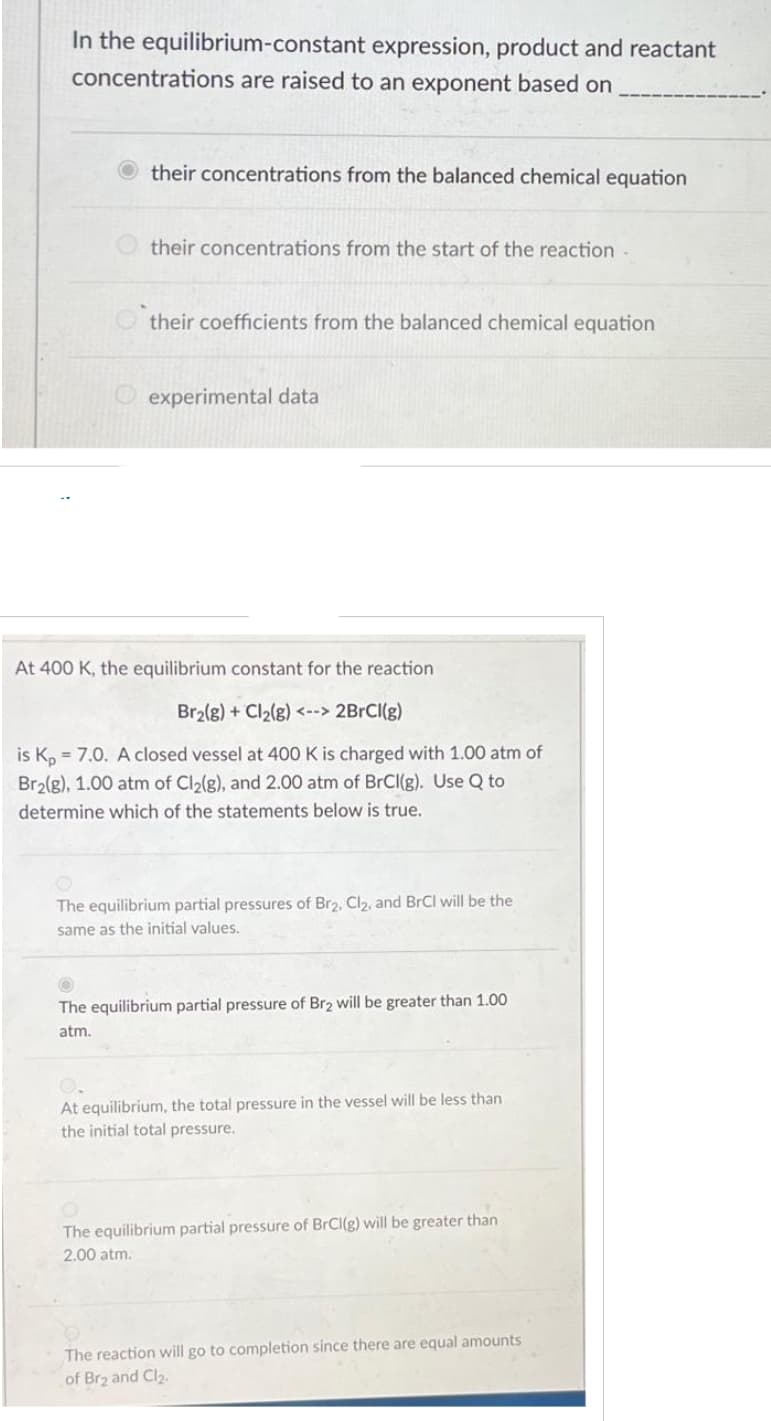In the equilibrium-constant expression, product and reactant concentrations are raised to an exponent based on their concentrations from the balanced chemical equation their concentrations from the start of the reaction Otheir coefficients from the balanced chemical equation experimental data
In the equilibrium-constant expression, product and reactant concentrations are raised to an exponent based on their concentrations from the balanced chemical equation their concentrations from the start of the reaction Otheir coefficients from the balanced chemical equation experimental data
Chemistry
10th Edition
ISBN:9781305957404
Author:Steven S. Zumdahl, Susan A. Zumdahl, Donald J. DeCoste
Publisher:Steven S. Zumdahl, Susan A. Zumdahl, Donald J. DeCoste
Chapter17: Spontaneity, Entropy, And Free Energy
Section: Chapter Questions
Problem 121CP: If wet silver carbonate is dried in a stream of hot air. the air must have a certain concentration...
Related questions
Question
Subject- chemistry

Transcribed Image Text:In the equilibrium-constant
concentrations are raised to an exponent based on
expression, product and reactant
their concentrations from the balanced chemical equation
their concentrations from the start of the reaction -
their coefficients from the balanced chemical equation
experimental data
At 400 K, the equilibrium constant for the reaction
Br₂(g) + Cl₂(g) <--> 2BrCl(g)
is Kp = 7.0. A closed vessel at 400 K is charged with 1.00 atm of
Br₂(g), 1.00 atm of Cl₂(g), and 2.00 atm of BrCl(g). Use Q to
determine which of the statements below is true.
The equilibrium partial pressures of Br₂, Cl₂, and BrCl will be the
same as the initial values.
The equilibrium partial pressure of Br2 will be greater than 1.00
atm.
At equilibrium, the total pressure in the vessel will be less than
the initial total pressure.
The equilibrium partial pressure of BrCl(g) will be greater than
2.00 atm.
The reaction will go to completion since there are equal amounts
of Br₂ and Cl₂.
Expert Solution
This question has been solved!
Explore an expertly crafted, step-by-step solution for a thorough understanding of key concepts.
This is a popular solution!
Trending now
This is a popular solution!
Step by step
Solved in 3 steps with 1 images

Knowledge Booster
Learn more about
Need a deep-dive on the concept behind this application? Look no further. Learn more about this topic, chemistry and related others by exploring similar questions and additional content below.Recommended textbooks for you

Chemistry
Chemistry
ISBN:
9781305957404
Author:
Steven S. Zumdahl, Susan A. Zumdahl, Donald J. DeCoste
Publisher:
Cengage Learning

Chemistry: An Atoms First Approach
Chemistry
ISBN:
9781305079243
Author:
Steven S. Zumdahl, Susan A. Zumdahl
Publisher:
Cengage Learning


Chemistry
Chemistry
ISBN:
9781305957404
Author:
Steven S. Zumdahl, Susan A. Zumdahl, Donald J. DeCoste
Publisher:
Cengage Learning

Chemistry: An Atoms First Approach
Chemistry
ISBN:
9781305079243
Author:
Steven S. Zumdahl, Susan A. Zumdahl
Publisher:
Cengage Learning


Principles of Modern Chemistry
Chemistry
ISBN:
9781305079113
Author:
David W. Oxtoby, H. Pat Gillis, Laurie J. Butler
Publisher:
Cengage Learning

Introduction to General, Organic and Biochemistry
Chemistry
ISBN:
9781285869759
Author:
Frederick A. Bettelheim, William H. Brown, Mary K. Campbell, Shawn O. Farrell, Omar Torres
Publisher:
Cengage Learning

Chemistry: The Molecular Science
Chemistry
ISBN:
9781285199047
Author:
John W. Moore, Conrad L. Stanitski
Publisher:
Cengage Learning